Strategic Analysis of Huawei: Innovation, SWOT, and PESTEL
VerifiedAdded on 2022/09/01
|18
|3784
|24
Report
AI Summary
This report provides a comprehensive strategic analysis of Huawei Technologies, examining its journey from a small workshop to a global ICT leader. It begins with an introduction to Huawei, followed by a detailed SWOT analysis to assess its internal strengths and weaknesses, as well as external opportunities and threats. The report then employs a PESTEL analysis to evaluate the political, economic, social, technological, environmental, and legal factors influencing Huawei's operations. Furthermore, the analysis delves into the company's innovative capabilities, discussing how innovation drives change and how Huawei's management acts as change agents. The report also explores the challenges of organizational change and includes recommendations for continued success. The analysis incorporates key concepts such as innovation, change management, and strategic positioning, offering insights into Huawei's competitive advantage and future prospects.
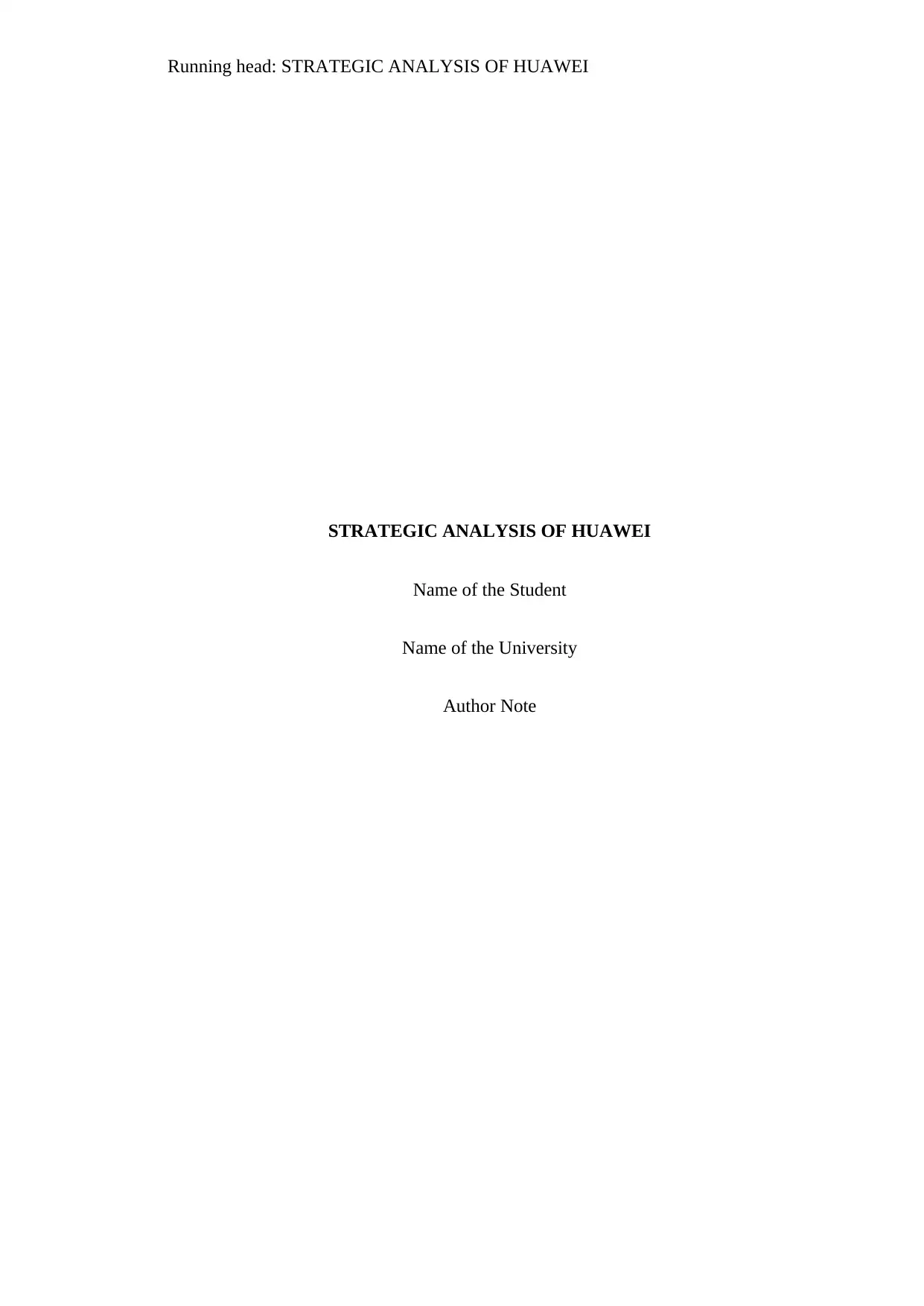
Running head: STRATEGIC ANALYSIS OF HUAWEI
STRATEGIC ANALYSIS OF HUAWEI
Name of the Student
Name of the University
Author Note
STRATEGIC ANALYSIS OF HUAWEI
Name of the Student
Name of the University
Author Note
Paraphrase This Document
Need a fresh take? Get an instant paraphrase of this document with our AI Paraphraser
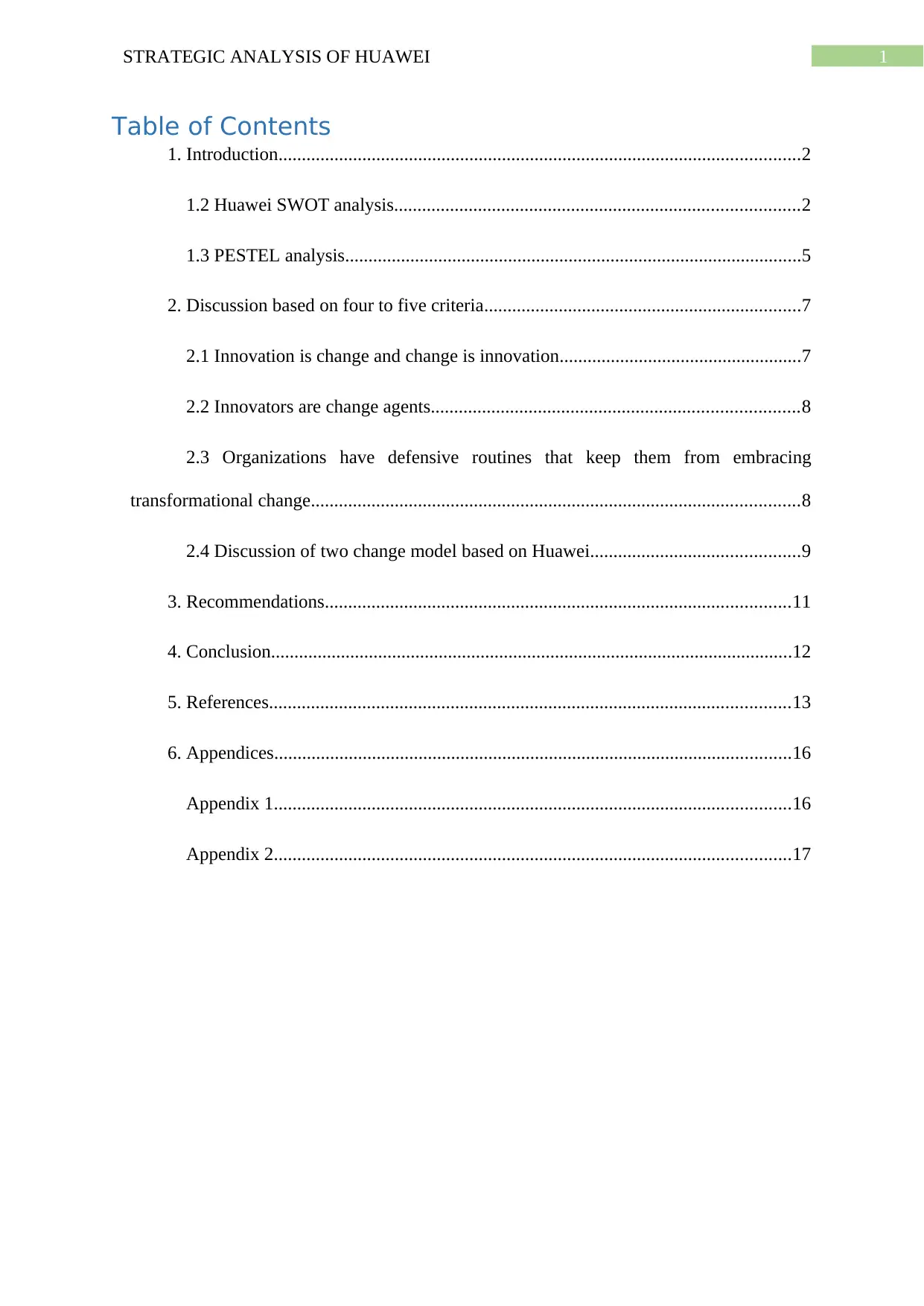
1STRATEGIC ANALYSIS OF HUAWEI
Table of Contents
1. Introduction................................................................................................................2
1.2 Huawei SWOT analysis.......................................................................................2
1.3 PESTEL analysis..................................................................................................5
2. Discussion based on four to five criteria....................................................................7
2.1 Innovation is change and change is innovation....................................................7
2.2 Innovators are change agents...............................................................................8
2.3 Organizations have defensive routines that keep them from embracing
transformational change.........................................................................................................8
2.4 Discussion of two change model based on Huawei.............................................9
3. Recommendations....................................................................................................11
4. Conclusion................................................................................................................12
5. References................................................................................................................13
6. Appendices...............................................................................................................16
Appendix 1...............................................................................................................16
Appendix 2...............................................................................................................17
Table of Contents
1. Introduction................................................................................................................2
1.2 Huawei SWOT analysis.......................................................................................2
1.3 PESTEL analysis..................................................................................................5
2. Discussion based on four to five criteria....................................................................7
2.1 Innovation is change and change is innovation....................................................7
2.2 Innovators are change agents...............................................................................8
2.3 Organizations have defensive routines that keep them from embracing
transformational change.........................................................................................................8
2.4 Discussion of two change model based on Huawei.............................................9
3. Recommendations....................................................................................................11
4. Conclusion................................................................................................................12
5. References................................................................................................................13
6. Appendices...............................................................................................................16
Appendix 1...............................................................................................................16
Appendix 2...............................................................................................................17
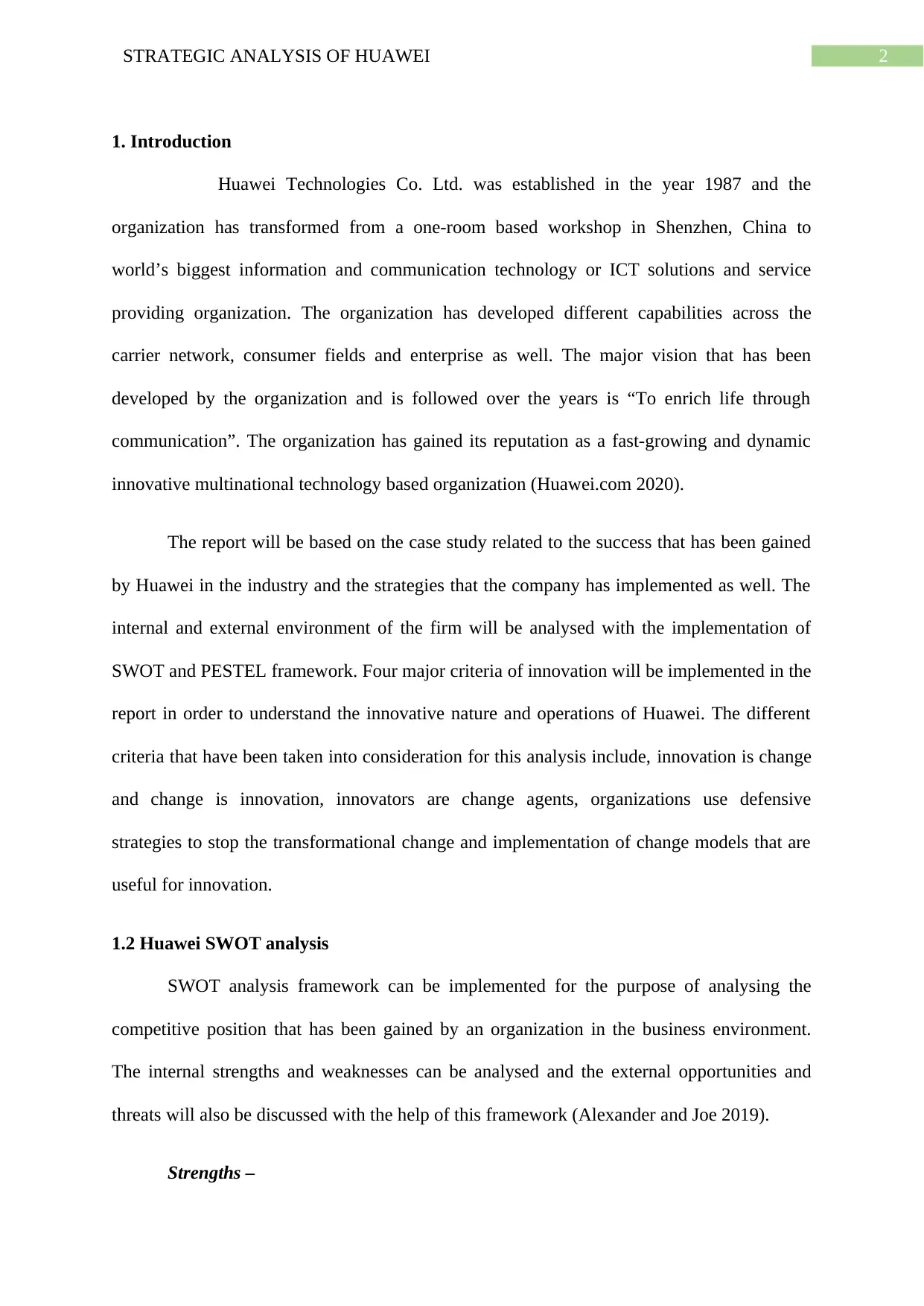
2STRATEGIC ANALYSIS OF HUAWEI
1. Introduction
Huawei Technologies Co. Ltd. was established in the year 1987 and the
organization has transformed from a one-room based workshop in Shenzhen, China to
world’s biggest information and communication technology or ICT solutions and service
providing organization. The organization has developed different capabilities across the
carrier network, consumer fields and enterprise as well. The major vision that has been
developed by the organization and is followed over the years is “To enrich life through
communication”. The organization has gained its reputation as a fast-growing and dynamic
innovative multinational technology based organization (Huawei.com 2020).
The report will be based on the case study related to the success that has been gained
by Huawei in the industry and the strategies that the company has implemented as well. The
internal and external environment of the firm will be analysed with the implementation of
SWOT and PESTEL framework. Four major criteria of innovation will be implemented in the
report in order to understand the innovative nature and operations of Huawei. The different
criteria that have been taken into consideration for this analysis include, innovation is change
and change is innovation, innovators are change agents, organizations use defensive
strategies to stop the transformational change and implementation of change models that are
useful for innovation.
1.2 Huawei SWOT analysis
SWOT analysis framework can be implemented for the purpose of analysing the
competitive position that has been gained by an organization in the business environment.
The internal strengths and weaknesses can be analysed and the external opportunities and
threats will also be discussed with the help of this framework (Alexander and Joe 2019).
Strengths –
1. Introduction
Huawei Technologies Co. Ltd. was established in the year 1987 and the
organization has transformed from a one-room based workshop in Shenzhen, China to
world’s biggest information and communication technology or ICT solutions and service
providing organization. The organization has developed different capabilities across the
carrier network, consumer fields and enterprise as well. The major vision that has been
developed by the organization and is followed over the years is “To enrich life through
communication”. The organization has gained its reputation as a fast-growing and dynamic
innovative multinational technology based organization (Huawei.com 2020).
The report will be based on the case study related to the success that has been gained
by Huawei in the industry and the strategies that the company has implemented as well. The
internal and external environment of the firm will be analysed with the implementation of
SWOT and PESTEL framework. Four major criteria of innovation will be implemented in the
report in order to understand the innovative nature and operations of Huawei. The different
criteria that have been taken into consideration for this analysis include, innovation is change
and change is innovation, innovators are change agents, organizations use defensive
strategies to stop the transformational change and implementation of change models that are
useful for innovation.
1.2 Huawei SWOT analysis
SWOT analysis framework can be implemented for the purpose of analysing the
competitive position that has been gained by an organization in the business environment.
The internal strengths and weaknesses can be analysed and the external opportunities and
threats will also be discussed with the help of this framework (Alexander and Joe 2019).
Strengths –
⊘ This is a preview!⊘
Do you want full access?
Subscribe today to unlock all pages.

Trusted by 1+ million students worldwide
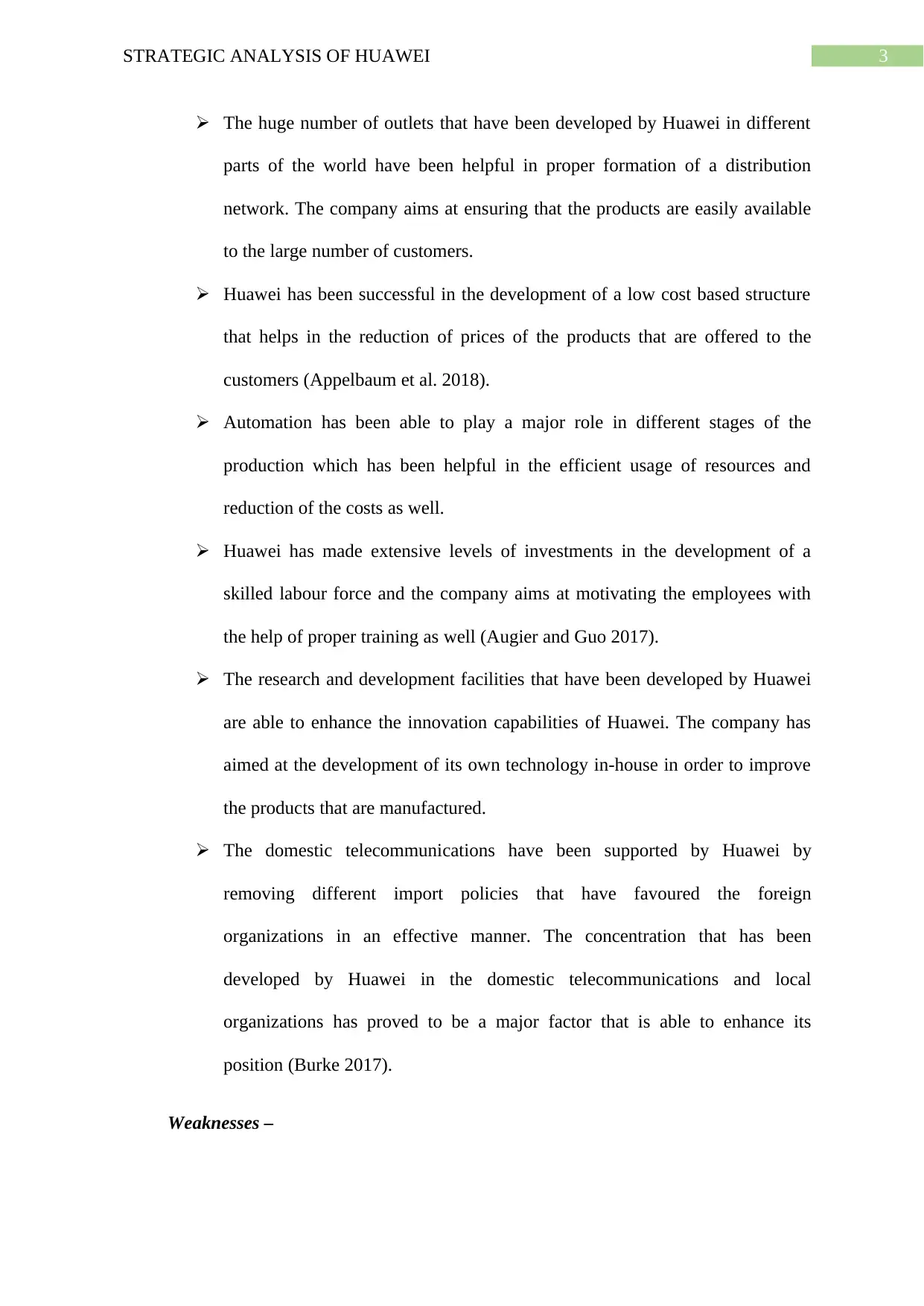
3STRATEGIC ANALYSIS OF HUAWEI
The huge number of outlets that have been developed by Huawei in different
parts of the world have been helpful in proper formation of a distribution
network. The company aims at ensuring that the products are easily available
to the large number of customers.
Huawei has been successful in the development of a low cost based structure
that helps in the reduction of prices of the products that are offered to the
customers (Appelbaum et al. 2018).
Automation has been able to play a major role in different stages of the
production which has been helpful in the efficient usage of resources and
reduction of the costs as well.
Huawei has made extensive levels of investments in the development of a
skilled labour force and the company aims at motivating the employees with
the help of proper training as well (Augier and Guo 2017).
The research and development facilities that have been developed by Huawei
are able to enhance the innovation capabilities of Huawei. The company has
aimed at the development of its own technology in-house in order to improve
the products that are manufactured.
The domestic telecommunications have been supported by Huawei by
removing different import policies that have favoured the foreign
organizations in an effective manner. The concentration that has been
developed by Huawei in the domestic telecommunications and local
organizations has proved to be a major factor that is able to enhance its
position (Burke 2017).
Weaknesses –
The huge number of outlets that have been developed by Huawei in different
parts of the world have been helpful in proper formation of a distribution
network. The company aims at ensuring that the products are easily available
to the large number of customers.
Huawei has been successful in the development of a low cost based structure
that helps in the reduction of prices of the products that are offered to the
customers (Appelbaum et al. 2018).
Automation has been able to play a major role in different stages of the
production which has been helpful in the efficient usage of resources and
reduction of the costs as well.
Huawei has made extensive levels of investments in the development of a
skilled labour force and the company aims at motivating the employees with
the help of proper training as well (Augier and Guo 2017).
The research and development facilities that have been developed by Huawei
are able to enhance the innovation capabilities of Huawei. The company has
aimed at the development of its own technology in-house in order to improve
the products that are manufactured.
The domestic telecommunications have been supported by Huawei by
removing different import policies that have favoured the foreign
organizations in an effective manner. The concentration that has been
developed by Huawei in the domestic telecommunications and local
organizations has proved to be a major factor that is able to enhance its
position (Burke 2017).
Weaknesses –
Paraphrase This Document
Need a fresh take? Get an instant paraphrase of this document with our AI Paraphraser
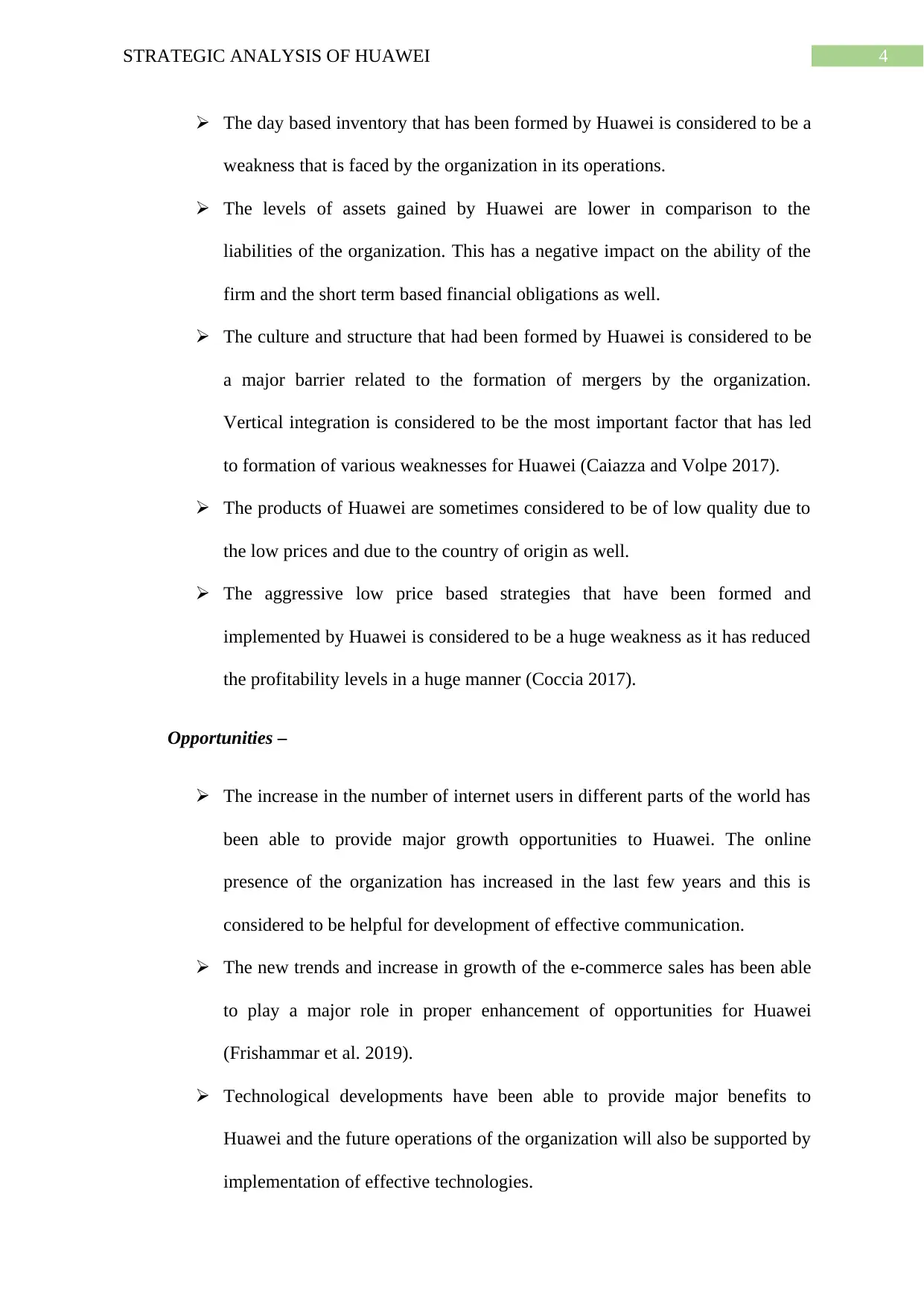
4STRATEGIC ANALYSIS OF HUAWEI
The day based inventory that has been formed by Huawei is considered to be a
weakness that is faced by the organization in its operations.
The levels of assets gained by Huawei are lower in comparison to the
liabilities of the organization. This has a negative impact on the ability of the
firm and the short term based financial obligations as well.
The culture and structure that had been formed by Huawei is considered to be
a major barrier related to the formation of mergers by the organization.
Vertical integration is considered to be the most important factor that has led
to formation of various weaknesses for Huawei (Caiazza and Volpe 2017).
The products of Huawei are sometimes considered to be of low quality due to
the low prices and due to the country of origin as well.
The aggressive low price based strategies that have been formed and
implemented by Huawei is considered to be a huge weakness as it has reduced
the profitability levels in a huge manner (Coccia 2017).
Opportunities –
The increase in the number of internet users in different parts of the world has
been able to provide major growth opportunities to Huawei. The online
presence of the organization has increased in the last few years and this is
considered to be helpful for development of effective communication.
The new trends and increase in growth of the e-commerce sales has been able
to play a major role in proper enhancement of opportunities for Huawei
(Frishammar et al. 2019).
Technological developments have been able to provide major benefits to
Huawei and the future operations of the organization will also be supported by
implementation of effective technologies.
The day based inventory that has been formed by Huawei is considered to be a
weakness that is faced by the organization in its operations.
The levels of assets gained by Huawei are lower in comparison to the
liabilities of the organization. This has a negative impact on the ability of the
firm and the short term based financial obligations as well.
The culture and structure that had been formed by Huawei is considered to be
a major barrier related to the formation of mergers by the organization.
Vertical integration is considered to be the most important factor that has led
to formation of various weaknesses for Huawei (Caiazza and Volpe 2017).
The products of Huawei are sometimes considered to be of low quality due to
the low prices and due to the country of origin as well.
The aggressive low price based strategies that have been formed and
implemented by Huawei is considered to be a huge weakness as it has reduced
the profitability levels in a huge manner (Coccia 2017).
Opportunities –
The increase in the number of internet users in different parts of the world has
been able to provide major growth opportunities to Huawei. The online
presence of the organization has increased in the last few years and this is
considered to be helpful for development of effective communication.
The new trends and increase in growth of the e-commerce sales has been able
to play a major role in proper enhancement of opportunities for Huawei
(Frishammar et al. 2019).
Technological developments have been able to provide major benefits to
Huawei and the future operations of the organization will also be supported by
implementation of effective technologies.
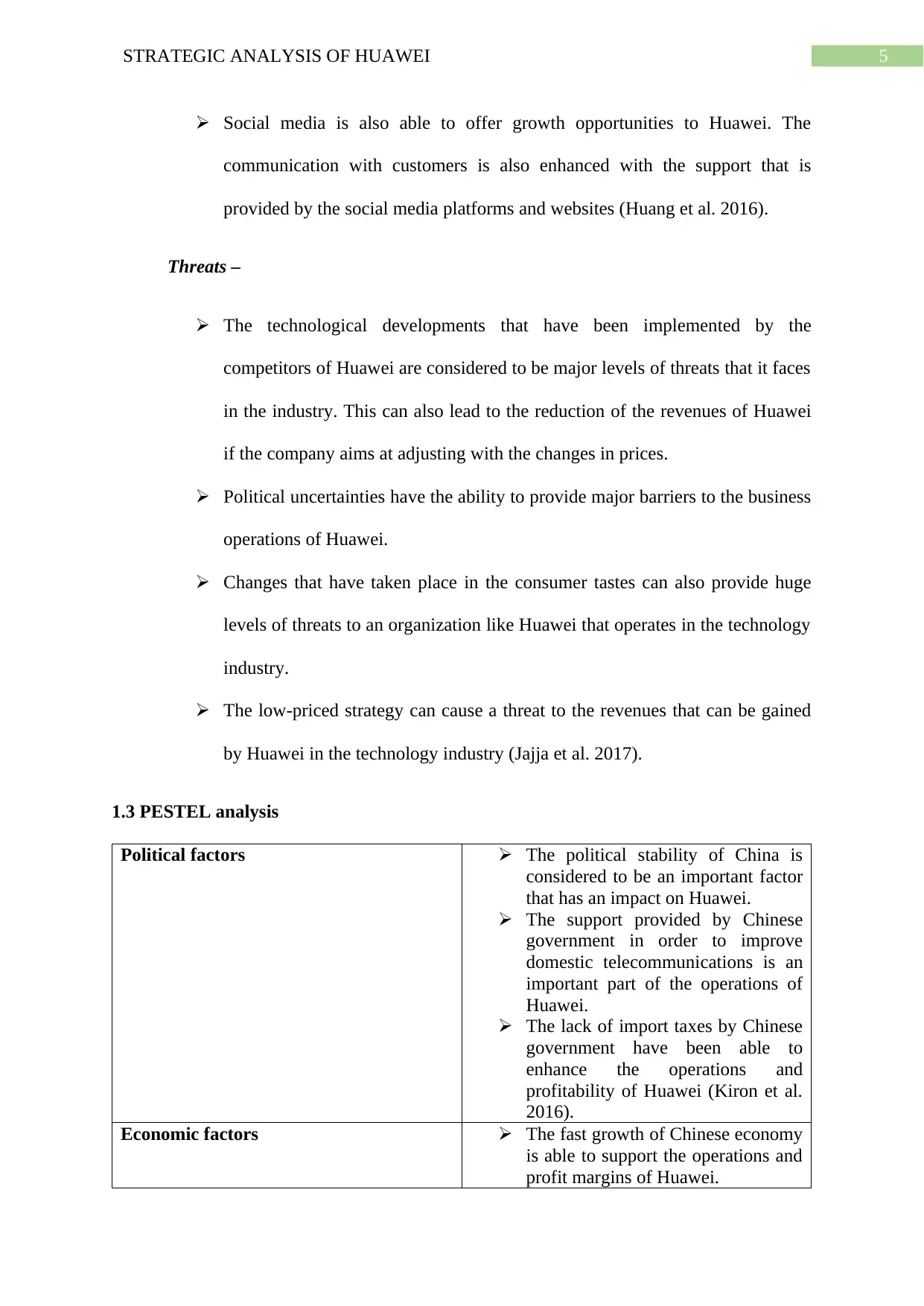
5STRATEGIC ANALYSIS OF HUAWEI
Social media is also able to offer growth opportunities to Huawei. The
communication with customers is also enhanced with the support that is
provided by the social media platforms and websites (Huang et al. 2016).
Threats –
The technological developments that have been implemented by the
competitors of Huawei are considered to be major levels of threats that it faces
in the industry. This can also lead to the reduction of the revenues of Huawei
if the company aims at adjusting with the changes in prices.
Political uncertainties have the ability to provide major barriers to the business
operations of Huawei.
Changes that have taken place in the consumer tastes can also provide huge
levels of threats to an organization like Huawei that operates in the technology
industry.
The low-priced strategy can cause a threat to the revenues that can be gained
by Huawei in the technology industry (Jajja et al. 2017).
1.3 PESTEL analysis
Political factors The political stability of China is
considered to be an important factor
that has an impact on Huawei.
The support provided by Chinese
government in order to improve
domestic telecommunications is an
important part of the operations of
Huawei.
The lack of import taxes by Chinese
government have been able to
enhance the operations and
profitability of Huawei (Kiron et al.
2016).
Economic factors The fast growth of Chinese economy
is able to support the operations and
profit margins of Huawei.
Social media is also able to offer growth opportunities to Huawei. The
communication with customers is also enhanced with the support that is
provided by the social media platforms and websites (Huang et al. 2016).
Threats –
The technological developments that have been implemented by the
competitors of Huawei are considered to be major levels of threats that it faces
in the industry. This can also lead to the reduction of the revenues of Huawei
if the company aims at adjusting with the changes in prices.
Political uncertainties have the ability to provide major barriers to the business
operations of Huawei.
Changes that have taken place in the consumer tastes can also provide huge
levels of threats to an organization like Huawei that operates in the technology
industry.
The low-priced strategy can cause a threat to the revenues that can be gained
by Huawei in the technology industry (Jajja et al. 2017).
1.3 PESTEL analysis
Political factors The political stability of China is
considered to be an important factor
that has an impact on Huawei.
The support provided by Chinese
government in order to improve
domestic telecommunications is an
important part of the operations of
Huawei.
The lack of import taxes by Chinese
government have been able to
enhance the operations and
profitability of Huawei (Kiron et al.
2016).
Economic factors The fast growth of Chinese economy
is able to support the operations and
profit margins of Huawei.
⊘ This is a preview!⊘
Do you want full access?
Subscribe today to unlock all pages.

Trusted by 1+ million students worldwide
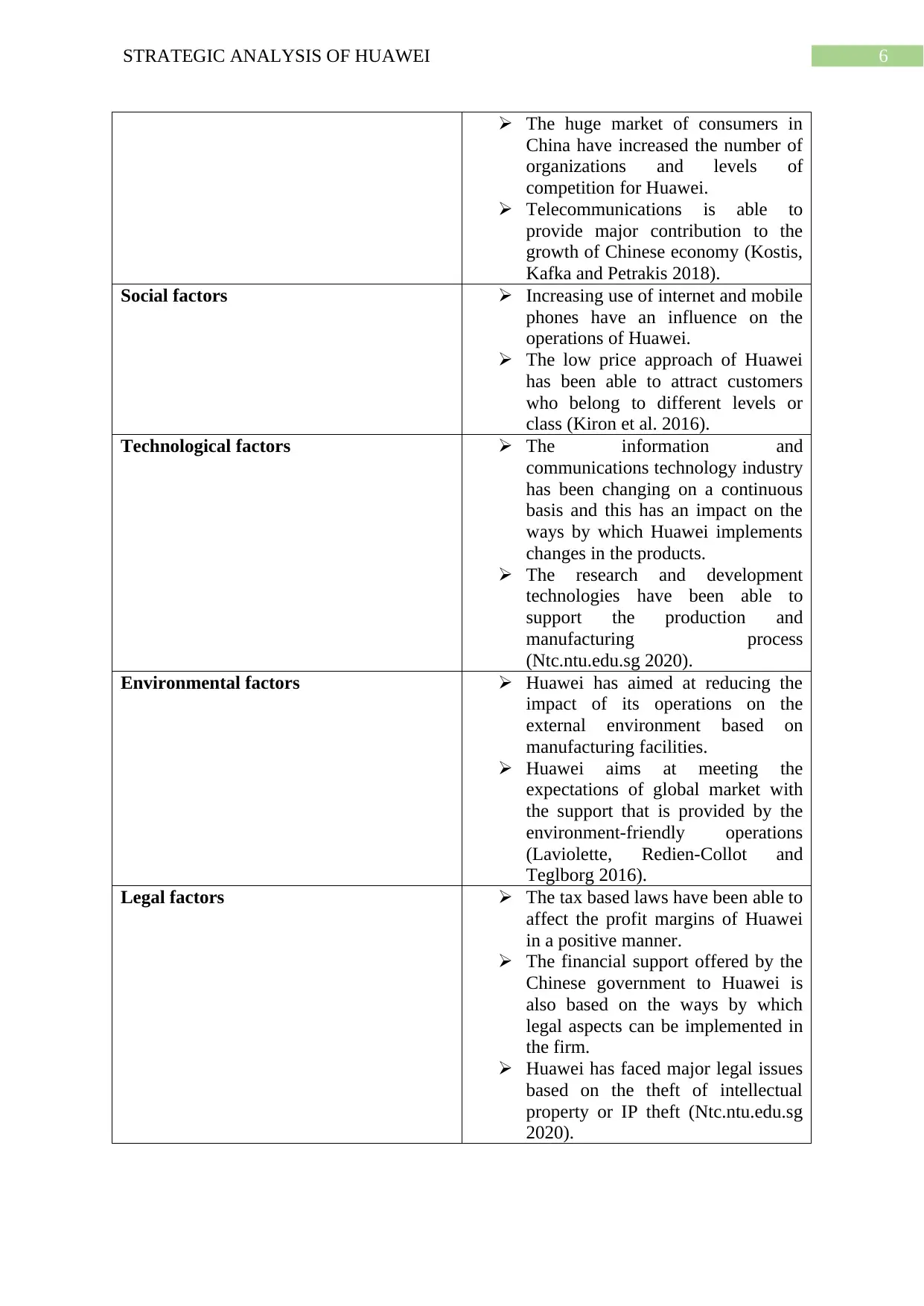
6STRATEGIC ANALYSIS OF HUAWEI
The huge market of consumers in
China have increased the number of
organizations and levels of
competition for Huawei.
Telecommunications is able to
provide major contribution to the
growth of Chinese economy (Kostis,
Kafka and Petrakis 2018).
Social factors Increasing use of internet and mobile
phones have an influence on the
operations of Huawei.
The low price approach of Huawei
has been able to attract customers
who belong to different levels or
class (Kiron et al. 2016).
Technological factors The information and
communications technology industry
has been changing on a continuous
basis and this has an impact on the
ways by which Huawei implements
changes in the products.
The research and development
technologies have been able to
support the production and
manufacturing process
(Ntc.ntu.edu.sg 2020).
Environmental factors Huawei has aimed at reducing the
impact of its operations on the
external environment based on
manufacturing facilities.
Huawei aims at meeting the
expectations of global market with
the support that is provided by the
environment-friendly operations
(Laviolette, Redien-Collot and
Teglborg 2016).
Legal factors The tax based laws have been able to
affect the profit margins of Huawei
in a positive manner.
The financial support offered by the
Chinese government to Huawei is
also based on the ways by which
legal aspects can be implemented in
the firm.
Huawei has faced major legal issues
based on the theft of intellectual
property or IP theft (Ntc.ntu.edu.sg
2020).
The huge market of consumers in
China have increased the number of
organizations and levels of
competition for Huawei.
Telecommunications is able to
provide major contribution to the
growth of Chinese economy (Kostis,
Kafka and Petrakis 2018).
Social factors Increasing use of internet and mobile
phones have an influence on the
operations of Huawei.
The low price approach of Huawei
has been able to attract customers
who belong to different levels or
class (Kiron et al. 2016).
Technological factors The information and
communications technology industry
has been changing on a continuous
basis and this has an impact on the
ways by which Huawei implements
changes in the products.
The research and development
technologies have been able to
support the production and
manufacturing process
(Ntc.ntu.edu.sg 2020).
Environmental factors Huawei has aimed at reducing the
impact of its operations on the
external environment based on
manufacturing facilities.
Huawei aims at meeting the
expectations of global market with
the support that is provided by the
environment-friendly operations
(Laviolette, Redien-Collot and
Teglborg 2016).
Legal factors The tax based laws have been able to
affect the profit margins of Huawei
in a positive manner.
The financial support offered by the
Chinese government to Huawei is
also based on the ways by which
legal aspects can be implemented in
the firm.
Huawei has faced major legal issues
based on the theft of intellectual
property or IP theft (Ntc.ntu.edu.sg
2020).
Paraphrase This Document
Need a fresh take? Get an instant paraphrase of this document with our AI Paraphraser
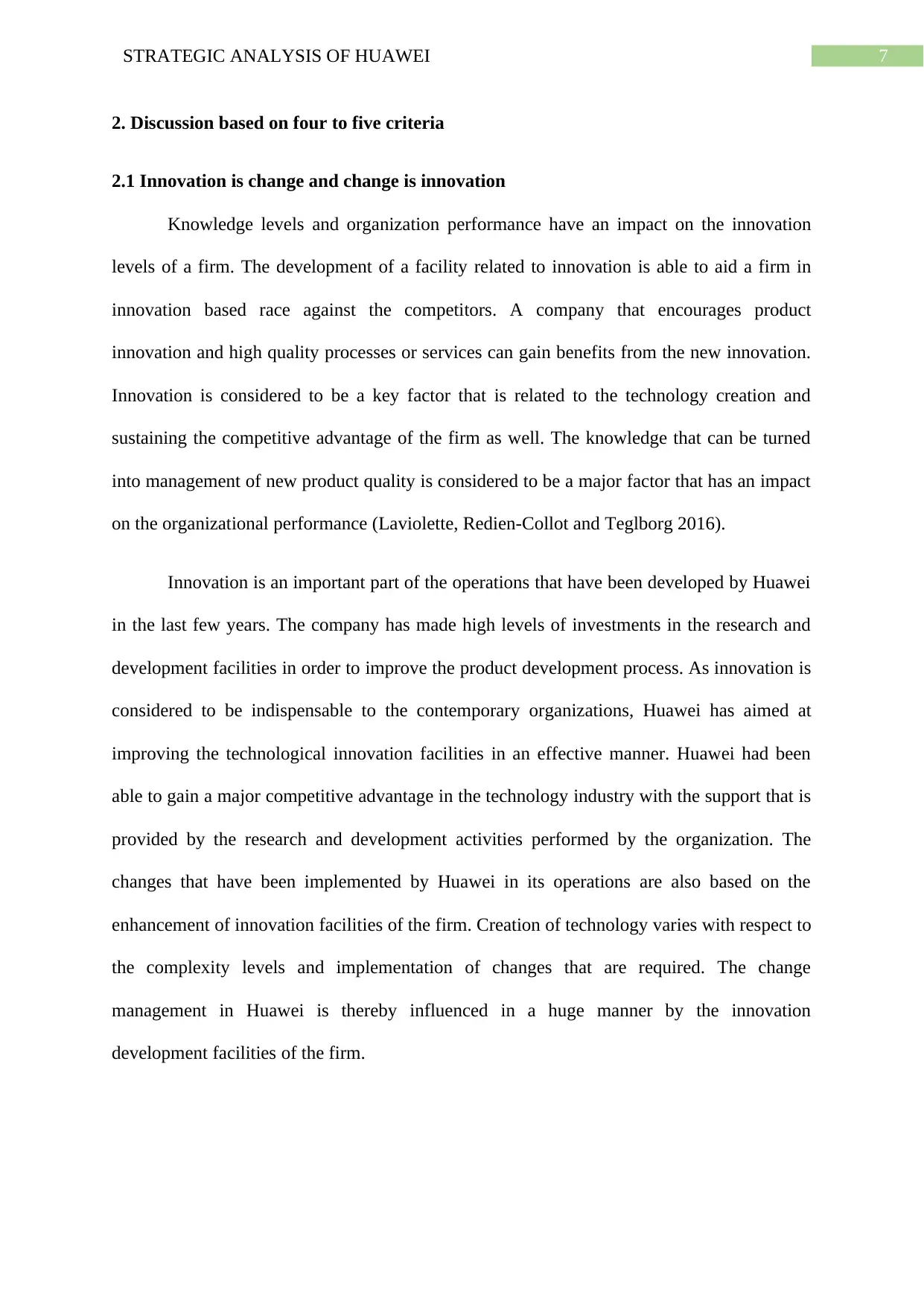
7STRATEGIC ANALYSIS OF HUAWEI
2. Discussion based on four to five criteria
2.1 Innovation is change and change is innovation
Knowledge levels and organization performance have an impact on the innovation
levels of a firm. The development of a facility related to innovation is able to aid a firm in
innovation based race against the competitors. A company that encourages product
innovation and high quality processes or services can gain benefits from the new innovation.
Innovation is considered to be a key factor that is related to the technology creation and
sustaining the competitive advantage of the firm as well. The knowledge that can be turned
into management of new product quality is considered to be a major factor that has an impact
on the organizational performance (Laviolette, Redien-Collot and Teglborg 2016).
Innovation is an important part of the operations that have been developed by Huawei
in the last few years. The company has made high levels of investments in the research and
development facilities in order to improve the product development process. As innovation is
considered to be indispensable to the contemporary organizations, Huawei has aimed at
improving the technological innovation facilities in an effective manner. Huawei had been
able to gain a major competitive advantage in the technology industry with the support that is
provided by the research and development activities performed by the organization. The
changes that have been implemented by Huawei in its operations are also based on the
enhancement of innovation facilities of the firm. Creation of technology varies with respect to
the complexity levels and implementation of changes that are required. The change
management in Huawei is thereby influenced in a huge manner by the innovation
development facilities of the firm.
2. Discussion based on four to five criteria
2.1 Innovation is change and change is innovation
Knowledge levels and organization performance have an impact on the innovation
levels of a firm. The development of a facility related to innovation is able to aid a firm in
innovation based race against the competitors. A company that encourages product
innovation and high quality processes or services can gain benefits from the new innovation.
Innovation is considered to be a key factor that is related to the technology creation and
sustaining the competitive advantage of the firm as well. The knowledge that can be turned
into management of new product quality is considered to be a major factor that has an impact
on the organizational performance (Laviolette, Redien-Collot and Teglborg 2016).
Innovation is an important part of the operations that have been developed by Huawei
in the last few years. The company has made high levels of investments in the research and
development facilities in order to improve the product development process. As innovation is
considered to be indispensable to the contemporary organizations, Huawei has aimed at
improving the technological innovation facilities in an effective manner. Huawei had been
able to gain a major competitive advantage in the technology industry with the support that is
provided by the research and development activities performed by the organization. The
changes that have been implemented by Huawei in its operations are also based on the
enhancement of innovation facilities of the firm. Creation of technology varies with respect to
the complexity levels and implementation of changes that are required. The change
management in Huawei is thereby influenced in a huge manner by the innovation
development facilities of the firm.
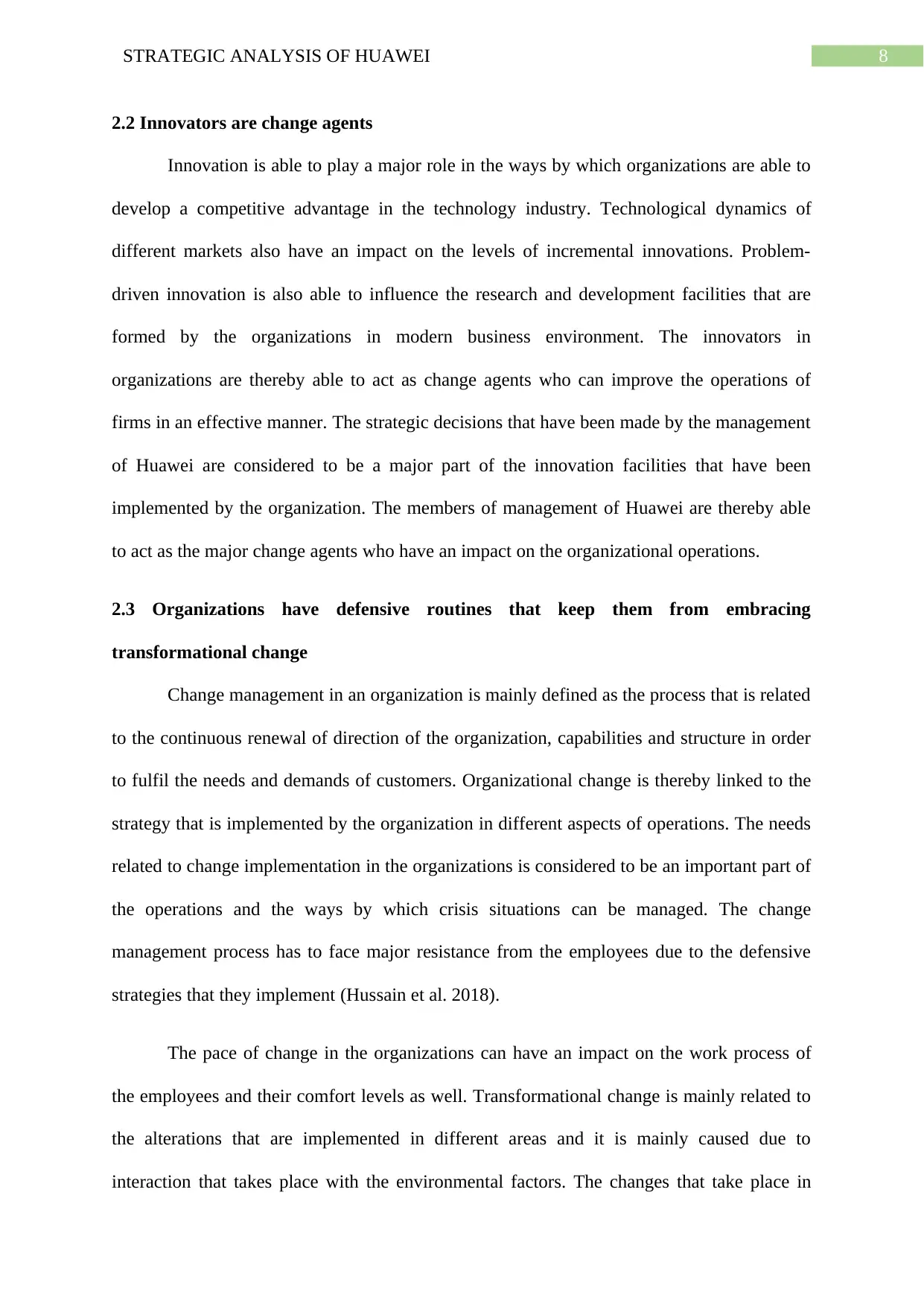
8STRATEGIC ANALYSIS OF HUAWEI
2.2 Innovators are change agents
Innovation is able to play a major role in the ways by which organizations are able to
develop a competitive advantage in the technology industry. Technological dynamics of
different markets also have an impact on the levels of incremental innovations. Problem-
driven innovation is also able to influence the research and development facilities that are
formed by the organizations in modern business environment. The innovators in
organizations are thereby able to act as change agents who can improve the operations of
firms in an effective manner. The strategic decisions that have been made by the management
of Huawei are considered to be a major part of the innovation facilities that have been
implemented by the organization. The members of management of Huawei are thereby able
to act as the major change agents who have an impact on the organizational operations.
2.3 Organizations have defensive routines that keep them from embracing
transformational change
Change management in an organization is mainly defined as the process that is related
to the continuous renewal of direction of the organization, capabilities and structure in order
to fulfil the needs and demands of customers. Organizational change is thereby linked to the
strategy that is implemented by the organization in different aspects of operations. The needs
related to change implementation in the organizations is considered to be an important part of
the operations and the ways by which crisis situations can be managed. The change
management process has to face major resistance from the employees due to the defensive
strategies that they implement (Hussain et al. 2018).
The pace of change in the organizations can have an impact on the work process of
the employees and their comfort levels as well. Transformational change is mainly related to
the alterations that are implemented in different areas and it is mainly caused due to
interaction that takes place with the environmental factors. The changes that take place in
2.2 Innovators are change agents
Innovation is able to play a major role in the ways by which organizations are able to
develop a competitive advantage in the technology industry. Technological dynamics of
different markets also have an impact on the levels of incremental innovations. Problem-
driven innovation is also able to influence the research and development facilities that are
formed by the organizations in modern business environment. The innovators in
organizations are thereby able to act as change agents who can improve the operations of
firms in an effective manner. The strategic decisions that have been made by the management
of Huawei are considered to be a major part of the innovation facilities that have been
implemented by the organization. The members of management of Huawei are thereby able
to act as the major change agents who have an impact on the organizational operations.
2.3 Organizations have defensive routines that keep them from embracing
transformational change
Change management in an organization is mainly defined as the process that is related
to the continuous renewal of direction of the organization, capabilities and structure in order
to fulfil the needs and demands of customers. Organizational change is thereby linked to the
strategy that is implemented by the organization in different aspects of operations. The needs
related to change implementation in the organizations is considered to be an important part of
the operations and the ways by which crisis situations can be managed. The change
management process has to face major resistance from the employees due to the defensive
strategies that they implement (Hussain et al. 2018).
The pace of change in the organizations can have an impact on the work process of
the employees and their comfort levels as well. Transformational change is mainly related to
the alterations that are implemented in different areas and it is mainly caused due to
interaction that takes place with the environmental factors. The changes that take place in
⊘ This is a preview!⊘
Do you want full access?
Subscribe today to unlock all pages.

Trusted by 1+ million students worldwide
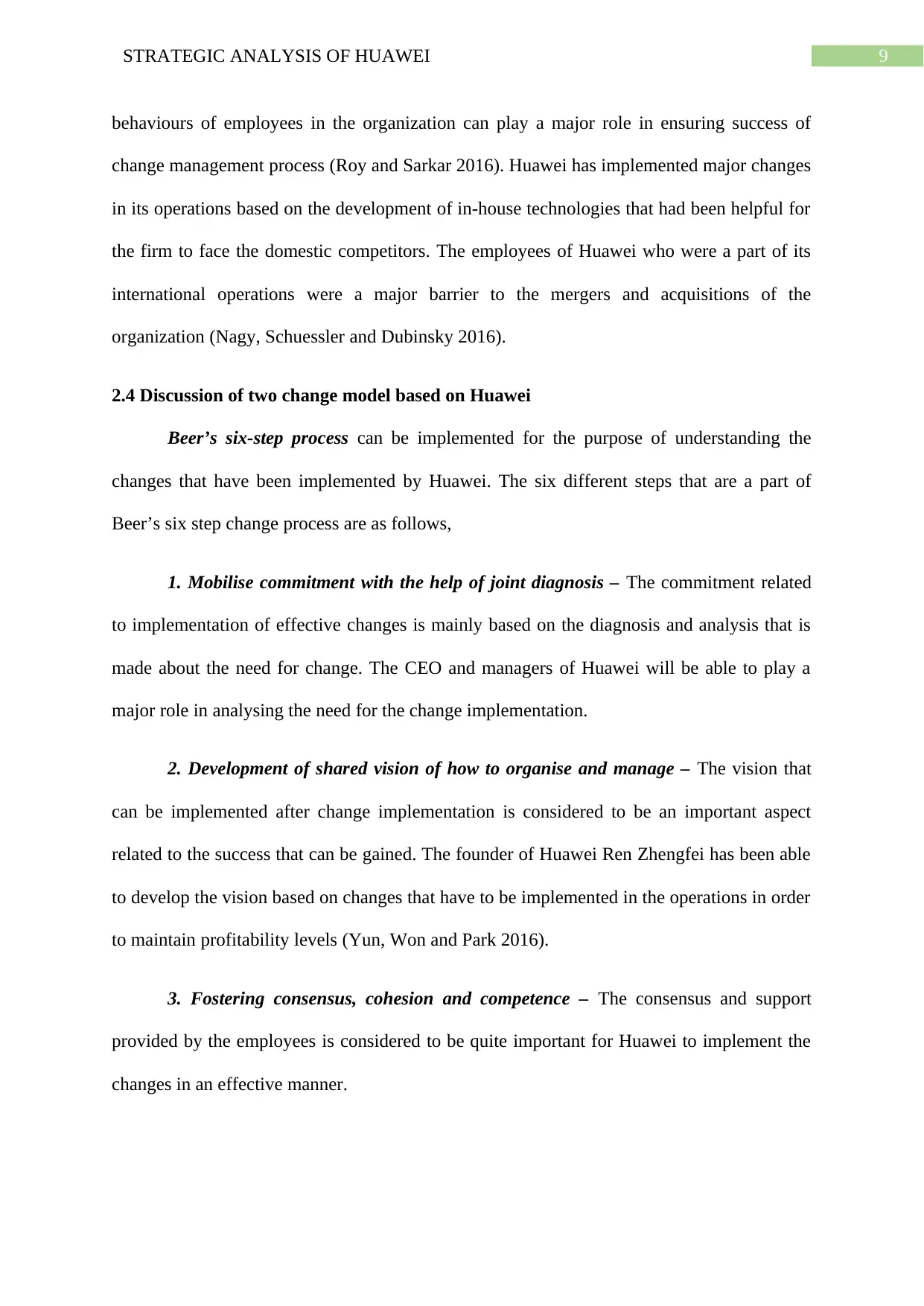
9STRATEGIC ANALYSIS OF HUAWEI
behaviours of employees in the organization can play a major role in ensuring success of
change management process (Roy and Sarkar 2016). Huawei has implemented major changes
in its operations based on the development of in-house technologies that had been helpful for
the firm to face the domestic competitors. The employees of Huawei who were a part of its
international operations were a major barrier to the mergers and acquisitions of the
organization (Nagy, Schuessler and Dubinsky 2016).
2.4 Discussion of two change model based on Huawei
Beer’s six-step process can be implemented for the purpose of understanding the
changes that have been implemented by Huawei. The six different steps that are a part of
Beer’s six step change process are as follows,
1. Mobilise commitment with the help of joint diagnosis – The commitment related
to implementation of effective changes is mainly based on the diagnosis and analysis that is
made about the need for change. The CEO and managers of Huawei will be able to play a
major role in analysing the need for the change implementation.
2. Development of shared vision of how to organise and manage – The vision that
can be implemented after change implementation is considered to be an important aspect
related to the success that can be gained. The founder of Huawei Ren Zhengfei has been able
to develop the vision based on changes that have to be implemented in the operations in order
to maintain profitability levels (Yun, Won and Park 2016).
3. Fostering consensus, cohesion and competence – The consensus and support
provided by the employees is considered to be quite important for Huawei to implement the
changes in an effective manner.
behaviours of employees in the organization can play a major role in ensuring success of
change management process (Roy and Sarkar 2016). Huawei has implemented major changes
in its operations based on the development of in-house technologies that had been helpful for
the firm to face the domestic competitors. The employees of Huawei who were a part of its
international operations were a major barrier to the mergers and acquisitions of the
organization (Nagy, Schuessler and Dubinsky 2016).
2.4 Discussion of two change model based on Huawei
Beer’s six-step process can be implemented for the purpose of understanding the
changes that have been implemented by Huawei. The six different steps that are a part of
Beer’s six step change process are as follows,
1. Mobilise commitment with the help of joint diagnosis – The commitment related
to implementation of effective changes is mainly based on the diagnosis and analysis that is
made about the need for change. The CEO and managers of Huawei will be able to play a
major role in analysing the need for the change implementation.
2. Development of shared vision of how to organise and manage – The vision that
can be implemented after change implementation is considered to be an important aspect
related to the success that can be gained. The founder of Huawei Ren Zhengfei has been able
to develop the vision based on changes that have to be implemented in the operations in order
to maintain profitability levels (Yun, Won and Park 2016).
3. Fostering consensus, cohesion and competence – The consensus and support
provided by the employees is considered to be quite important for Huawei to implement the
changes in an effective manner.
Paraphrase This Document
Need a fresh take? Get an instant paraphrase of this document with our AI Paraphraser
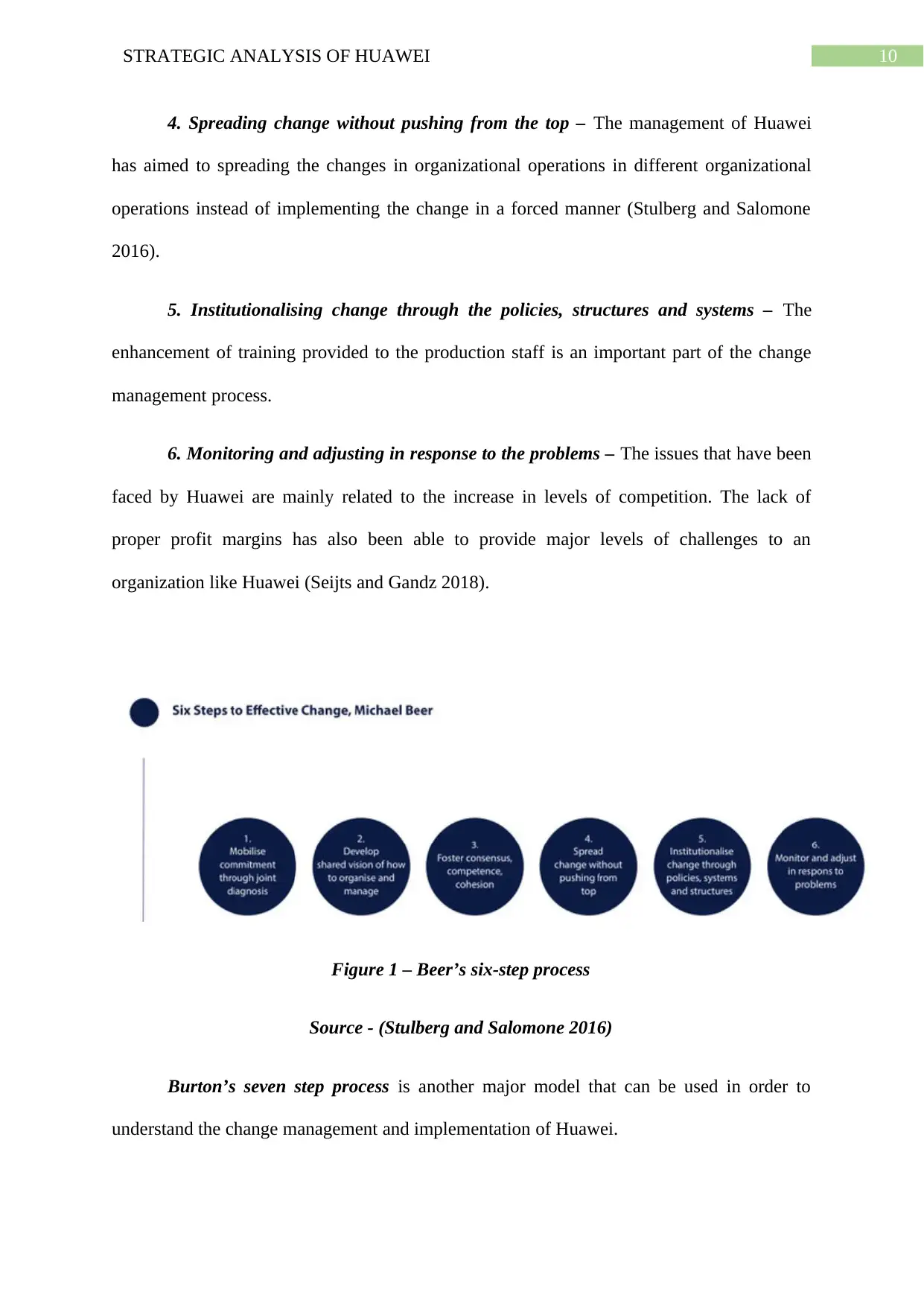
10STRATEGIC ANALYSIS OF HUAWEI
4. Spreading change without pushing from the top – The management of Huawei
has aimed to spreading the changes in organizational operations in different organizational
operations instead of implementing the change in a forced manner (Stulberg and Salomone
2016).
5. Institutionalising change through the policies, structures and systems – The
enhancement of training provided to the production staff is an important part of the change
management process.
6. Monitoring and adjusting in response to the problems – The issues that have been
faced by Huawei are mainly related to the increase in levels of competition. The lack of
proper profit margins has also been able to provide major levels of challenges to an
organization like Huawei (Seijts and Gandz 2018).
Figure 1 – Beer’s six-step process
Source - (Stulberg and Salomone 2016)
Burton’s seven step process is another major model that can be used in order to
understand the change management and implementation of Huawei.
4. Spreading change without pushing from the top – The management of Huawei
has aimed to spreading the changes in organizational operations in different organizational
operations instead of implementing the change in a forced manner (Stulberg and Salomone
2016).
5. Institutionalising change through the policies, structures and systems – The
enhancement of training provided to the production staff is an important part of the change
management process.
6. Monitoring and adjusting in response to the problems – The issues that have been
faced by Huawei are mainly related to the increase in levels of competition. The lack of
proper profit margins has also been able to provide major levels of challenges to an
organization like Huawei (Seijts and Gandz 2018).
Figure 1 – Beer’s six-step process
Source - (Stulberg and Salomone 2016)
Burton’s seven step process is another major model that can be used in order to
understand the change management and implementation of Huawei.
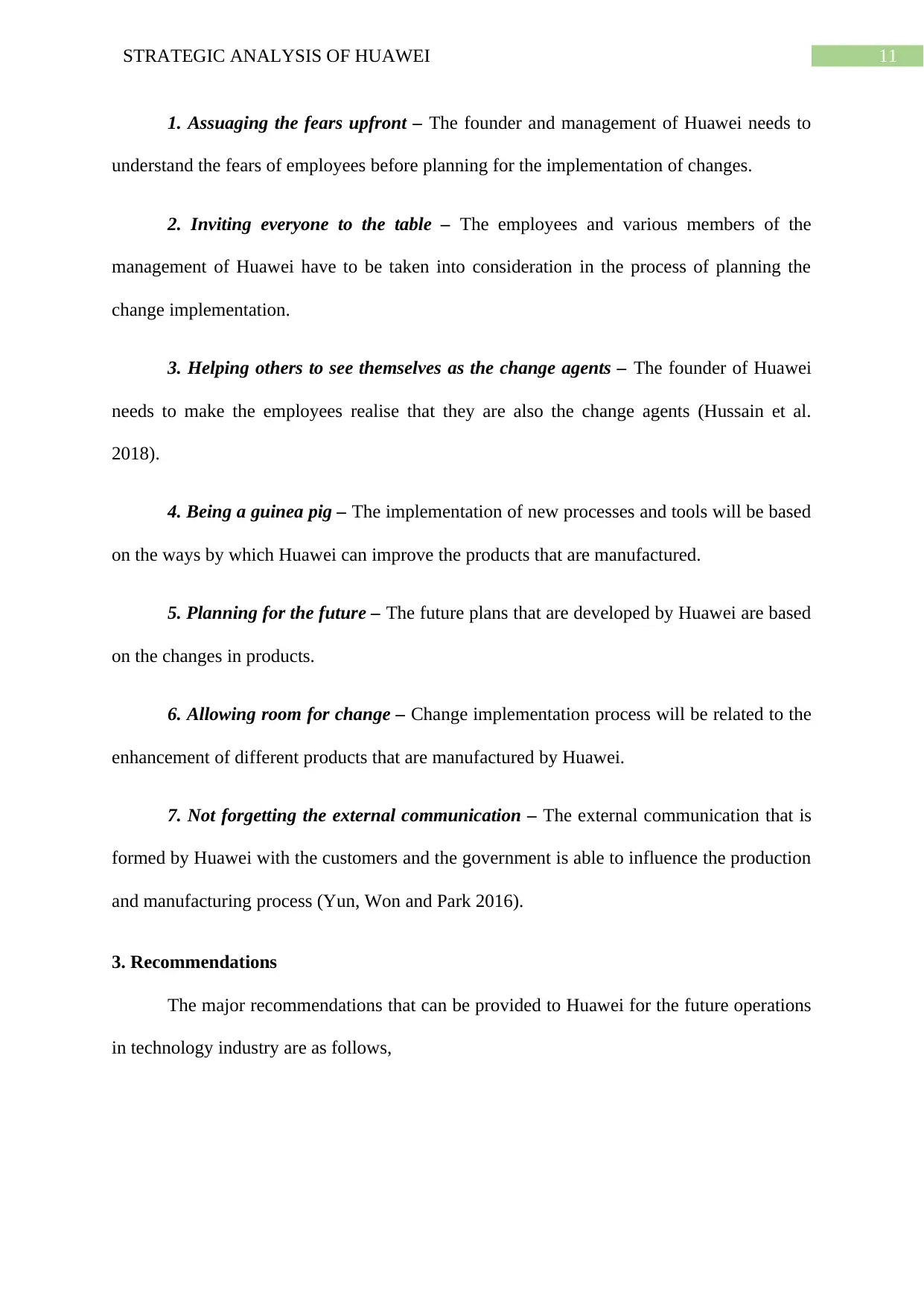
11STRATEGIC ANALYSIS OF HUAWEI
1. Assuaging the fears upfront – The founder and management of Huawei needs to
understand the fears of employees before planning for the implementation of changes.
2. Inviting everyone to the table – The employees and various members of the
management of Huawei have to be taken into consideration in the process of planning the
change implementation.
3. Helping others to see themselves as the change agents – The founder of Huawei
needs to make the employees realise that they are also the change agents (Hussain et al.
2018).
4. Being a guinea pig – The implementation of new processes and tools will be based
on the ways by which Huawei can improve the products that are manufactured.
5. Planning for the future – The future plans that are developed by Huawei are based
on the changes in products.
6. Allowing room for change – Change implementation process will be related to the
enhancement of different products that are manufactured by Huawei.
7. Not forgetting the external communication – The external communication that is
formed by Huawei with the customers and the government is able to influence the production
and manufacturing process (Yun, Won and Park 2016).
3. Recommendations
The major recommendations that can be provided to Huawei for the future operations
in technology industry are as follows,
1. Assuaging the fears upfront – The founder and management of Huawei needs to
understand the fears of employees before planning for the implementation of changes.
2. Inviting everyone to the table – The employees and various members of the
management of Huawei have to be taken into consideration in the process of planning the
change implementation.
3. Helping others to see themselves as the change agents – The founder of Huawei
needs to make the employees realise that they are also the change agents (Hussain et al.
2018).
4. Being a guinea pig – The implementation of new processes and tools will be based
on the ways by which Huawei can improve the products that are manufactured.
5. Planning for the future – The future plans that are developed by Huawei are based
on the changes in products.
6. Allowing room for change – Change implementation process will be related to the
enhancement of different products that are manufactured by Huawei.
7. Not forgetting the external communication – The external communication that is
formed by Huawei with the customers and the government is able to influence the production
and manufacturing process (Yun, Won and Park 2016).
3. Recommendations
The major recommendations that can be provided to Huawei for the future operations
in technology industry are as follows,
⊘ This is a preview!⊘
Do you want full access?
Subscribe today to unlock all pages.

Trusted by 1+ million students worldwide
1 out of 18
Related Documents
Your All-in-One AI-Powered Toolkit for Academic Success.
+13062052269
info@desklib.com
Available 24*7 on WhatsApp / Email
![[object Object]](/_next/static/media/star-bottom.7253800d.svg)
Unlock your academic potential
Copyright © 2020–2025 A2Z Services. All Rights Reserved. Developed and managed by ZUCOL.




